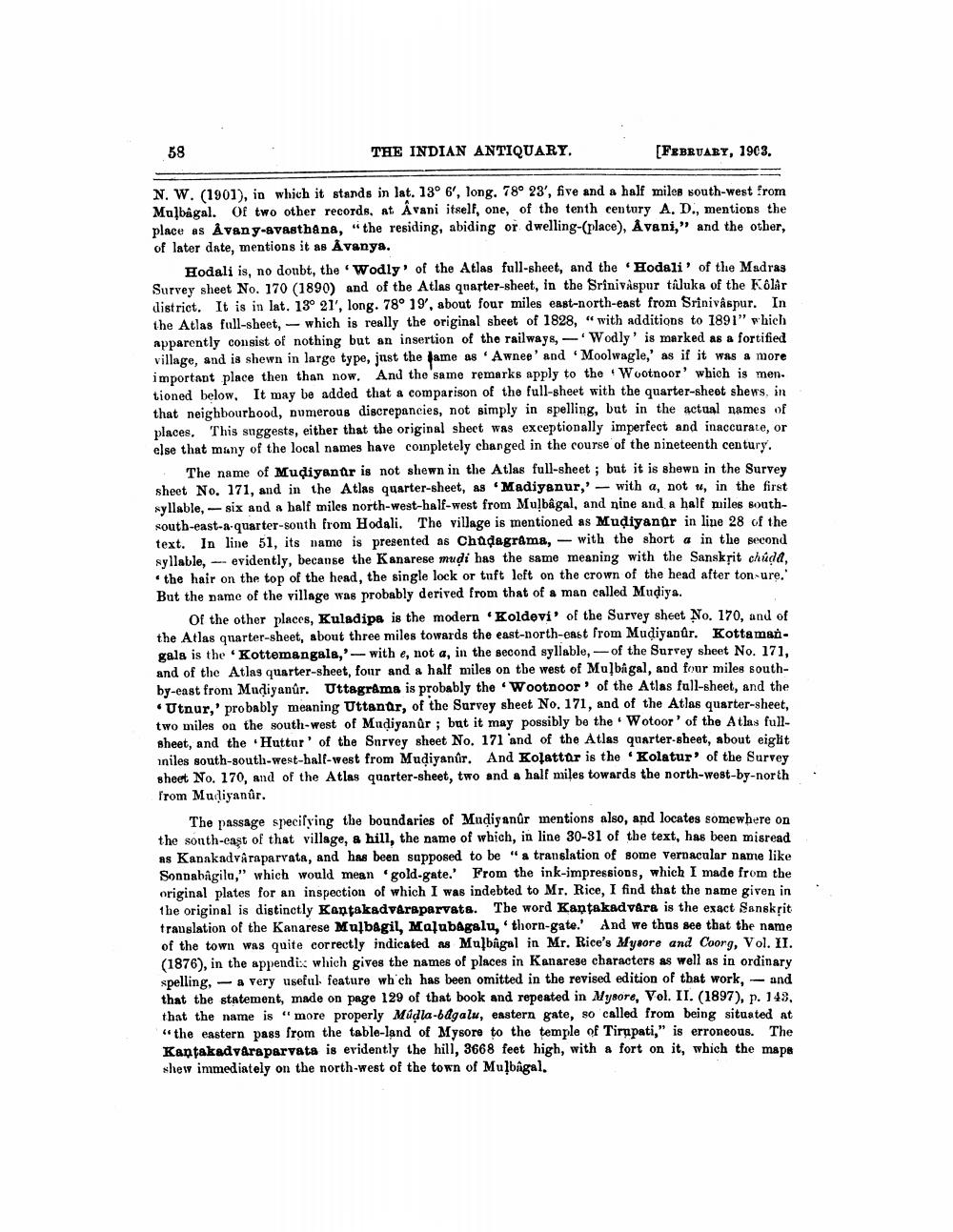________________
58
THE INDIAN ANTIQUARY.
[FEBRUARY, 1903.
N. W. (1901), in which it stands in lat. 13° 6', long. 78° 23', five and a half miles south-west !rom Mulbagal. Of two other records, at Āvani itself, one, of the tenth century A, D., mentions the place as Åveny-avasthana, “the residing, abiding or dwelling-(place), Åvani," and the other, of later date, mentions it as Åvanya.
Hodali is, no doubt, the Wodly' of the Atlas full-sheet, and the Hodali' of the Madras Survey sheet No. 170 (1890) and of the Atlas quarter-sheet, in the Srinivåspur tiuka of the Kolar district. It is in lat. 13° 21', long. 78° 19', about four miles east-north-east from Srinivåspur. In the Atlas full-sheet, - which is really the original sheet of 1828, "with additions to 1891" which apparently consist of nothing but an insertion of the railways, - Wodly' is marked as a fortified village, and is shewn in large type, just the fame as 'Awnee' and Moolwagle,' as if it was a more important place then than now. And the same remarks apply to the Wootnoor' which is men. tioned below. It may be added that a comparison of the full-sheet with the quarter-sheet shews, in that neighbourhood, numerous discrepancies, not simply in spelling, but in the actual names of places. This suggests, either that the original sheet was exceptionally imperfect and inaccurate, or else that many of the local names have completely changed in the course of the nineteenth century.
The name of Mudiyantr is not shewn in the Atlas full-sheet ; but it is shewn in the Survey sheet No. 171, and in the Atlas quarter-sheet, as 'Madiyanur,' - with a, not u, in the first syllable, -six and a half miles north-west-half-west from Muļbâgal, and nine and a half miles southsouth-east-a-quarter-sonth from Hodali. The village is mentioned as Mudiyanar in line 28 of the text. In line 51, its name is presented as Chadagrama, - with the short a in the second syllable, -- evidently, becanse the Kanarese mudi has the same meaning with the Sanskrit chúda,
the hair on the top of the head, the single lock or tuft left on the crown of the head after ton-ure. But the name of the village was probably derived from that of a man called Mudiya.
of the other places, Kuladipa is the modern Koldovi' of the Survey sheet No. 170, and of the Atlas quarter-sheet, about three miles towards the east-north-east from Mudiyanûr. Kottaman. gala is the 'Kottemangale,' - with e, not a, in the second syllable, -of the Survey sheet No. 171, and of the Atlas quarter-sheet, four and a half miles on the west of Mulbagal, and four miles southby-east from Mudiyanür. Uttagråma is probably the 'Wootnoor' of the Atlas full-sheet, and the •Utnur,' probably meaning Uttantr, of the Survey sheet No. 171, and of the Atlas quarter-sheet, two miles on the south-west of Mudiyanür ; but it may possibly be the Wotoor of the Atlas fullsheet, and the Huttur' of the Survey sheet No. 171 and of the Atlas quarter-sheet, about eight iniles south-south-west-half-west from Mudiyanür. And Kolattor is the Kolatur' of the Survey sheet No. 170, and of the Atlas quarter-sheet, two and a half miles towards the north-west-by-north from Mudiyanûr.
The passage specifying the boundaries of Mudiyanûr mentions also, and locates somewhere on the sonth-east of that village, a hill, the name of which, in line 30-31 of the text, has been misread as Kanakadvaraparvata, and has been supposed to be "a translation of some vernacular name like Sonnabagila," which would mean 'gold-gate. From the ink-impressions, which I made from the original plates for an inspection of which I was indebted to Mr. Rice, I find that the name given in the original is distinctly Kantakadvarsparvata. The word Kantakadvara is the exact Sanskrit translation of the Kanarese Mulbagil, Malubagalu, thorn-gate.' And we thus see that the name of the town was quite correctly indicated as Mulbîgal in Mr. Rice's Mysore and Coorg, Vol. II. (1876), in the appendix which gives the names of places in Kanarege characters as well as in ordinary spelling, - a very useful feature wh'ch has been omitted in the revised edition of that work, - and that the statement, made on page 129 of that book and repeated in Mysore, Vol. II. (1897), p. 143, that the name is "more properly Madla-bagalu, eastern gate, so called from being situated at "the eastern pass from the table-land of Mysore to the temple of Tirupati," is erroneous. The Kantakadvaraparvata is evidently the hill, 3668 feet high, with a fort on it, which the mape shew immediately on the north-west of the town of Mulbagal.
.




